Understanding the Challenge of School Refusal
School refusal behavior affects approximately 5% of school-age children and is a complex issue often rooted in underlying mental health conditions such as anxiety, depression, and trauma-related disorders rather than solely misbehavior or rebellion. This behavior not only disrupts academic progress but also intensifies emotional distress and social isolation. Comprehensive solutions require a multifaceted approach that integrates mental health treatment with educational support and family involvement. This article explores evidence-based interventions and the role of schools and caregivers in resolving school refusal and promoting youth well-being.
Defining School Refusal Behavior in Youth
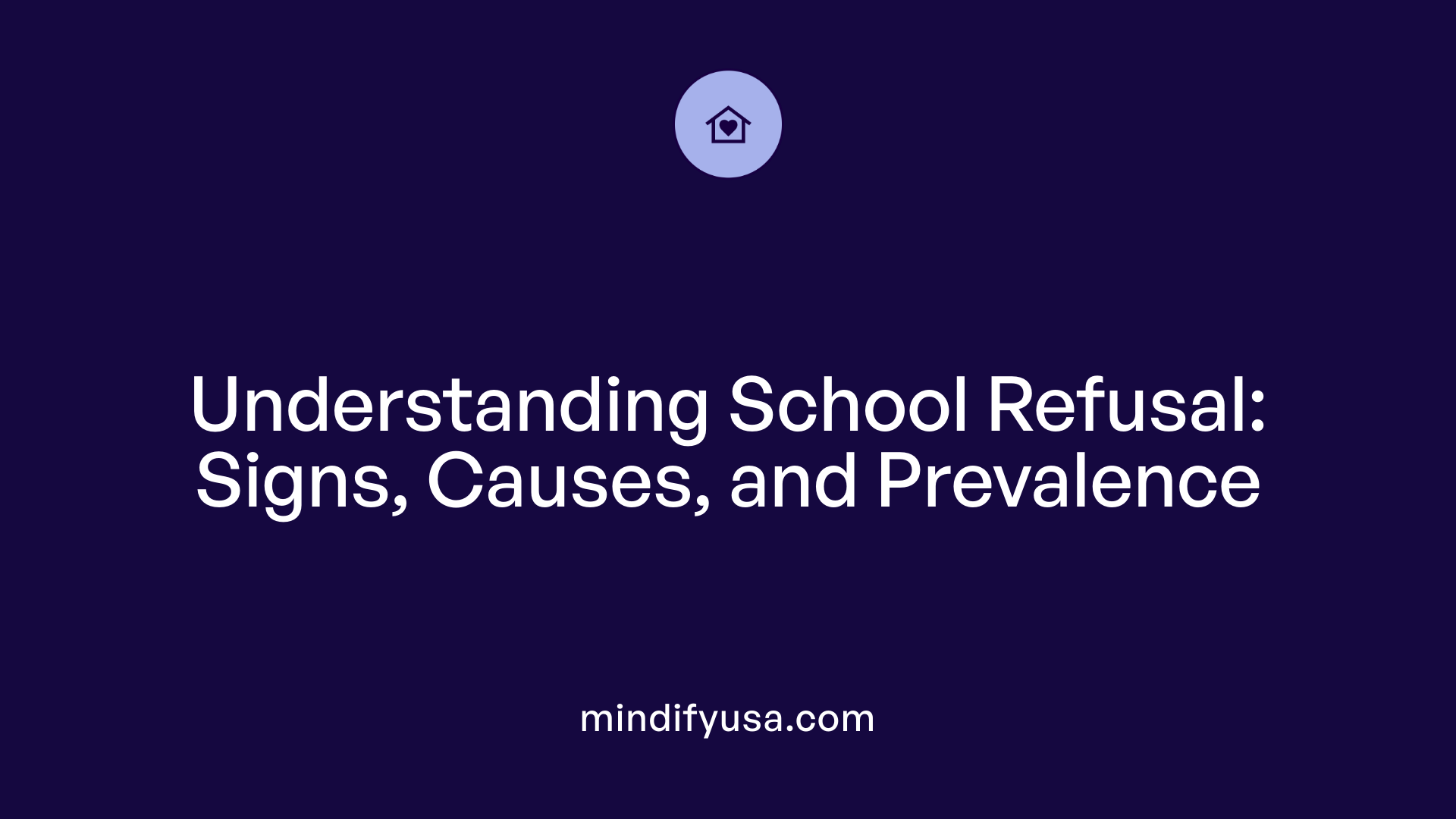
What is school refusal behavior and how prevalent is it among youth?
School refusal behavior refers to a child's persistent refusal to attend or stay in school. This behavior often goes beyond typical school anxiety and may include complaints of physical symptoms like headaches or stomachaches, emotional distress such as fear or sadness, or outright resistance to going to school.
This issue affects approximately 5% of all school-age children. It's closely linked to mental health conditions including social anxiety disorder, generalized anxiety, depression, and post-traumatic stress disorder (PTSD).
Behavioral characteristics of school refusal
Children displaying school refusal often show reluctance or outright refusal to attend school, frequently accompanied by physical complaints that may seem psychosomatic. Emotional signs such as anxiety, fear, irritability, or anger are common. Some children may also exhibit attention-seeking behaviors or social withdrawal. These behaviors collectively interfere with consistent school attendance and can lead to further academic and social difficulties.
Common underlying causes
School refusal is typically rooted in psychological factors rather than rebellion. Common causes include separation anxiety, social fears (such as fear of social situations or bullying), trauma from unsafe environments, or fear of negative academic experiences. Additionally, some children may refuse school to access preferred activities outside of school, though this is less typical.
Understanding these causes is essential for effective intervention. Recognizing that school refusal behaviors often stem from anxiety, fear, or emotional overwhelm helps guide supportive approaches focusing on mental health and gradual reintegration into school life.
Root Causes of School Refusal: Anxiety, Depression, and Trauma
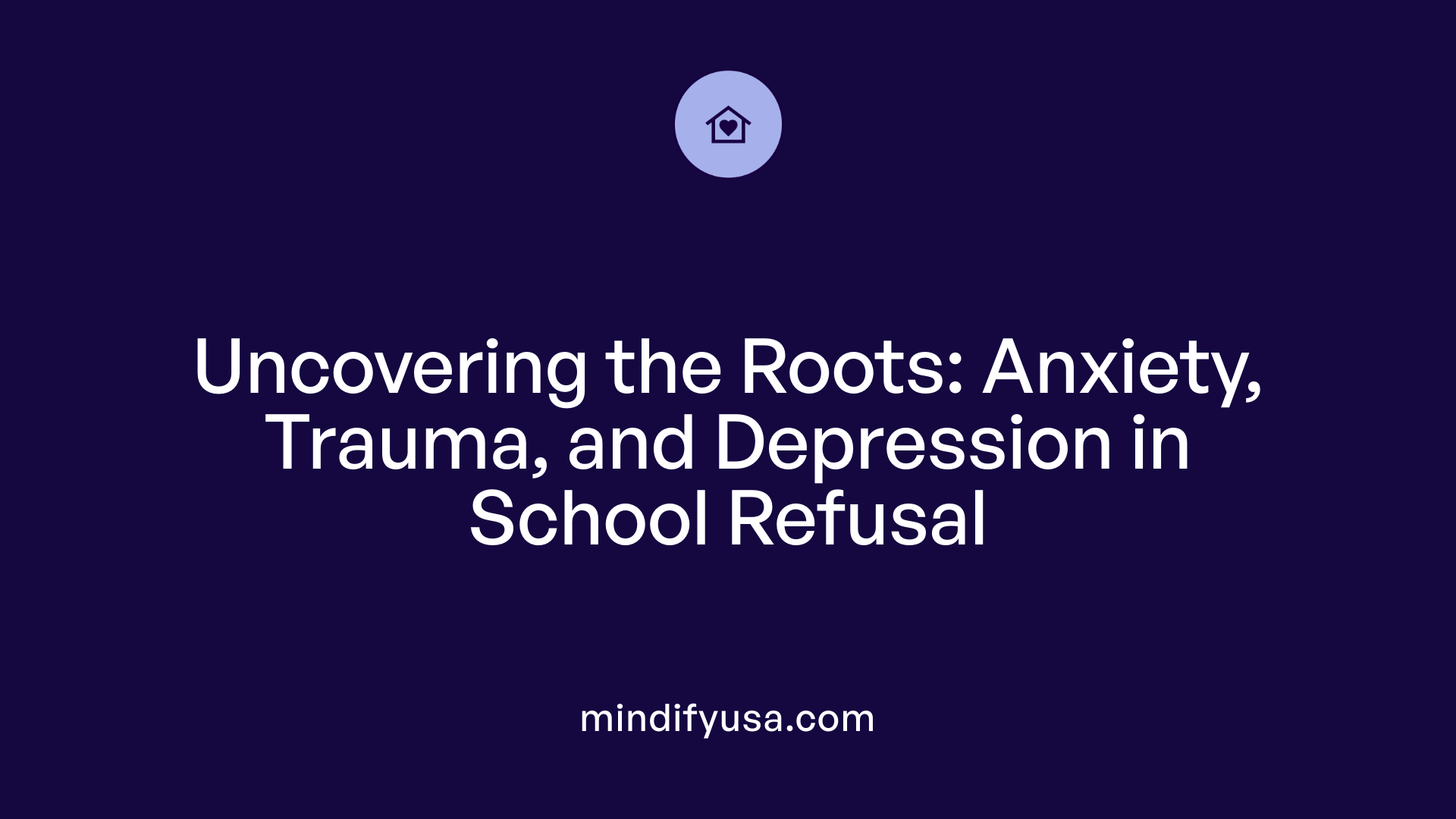
What underlying mental health issues contribute to school refusal behavior?
School refusal behavior is commonly rooted in a blend of mental health challenges rather than willful disobedience. Anxiety disorders are among the most significant contributors, including separation anxiety where children fear being apart from caregivers, and social phobia, which causes intense fear of social situations found in school settings. Generalized anxiety or fears related to bullying, academic performance, or traumatic experiences can also prompt avoidance.
Trauma and PTSD play a critical role when children have been exposed to stressful or harmful events such as school violence or abuse. The perception of school as an unsafe place can lead to persistent avoidance behaviors linked to trauma symptoms like flashbacks, hypervigilance, and emotional distress.
Depression manifests in school refusers as prolonged sadness, loss of interest in usual activities, fatigue, and diminished motivation. These symptoms frequently intensify with increased absenteeism, further impairing a child’s ability to engage academically and socially.
Together, these underlying psychological factors—separation anxiety, social phobia, trauma-related stress, and depression—form the foundation of school refusal. Recognizing and addressing these mental health issues is essential to developing effective interventions and supporting children’s successful reintegration into educational environments.
The Importance of Early Identification and Assessment
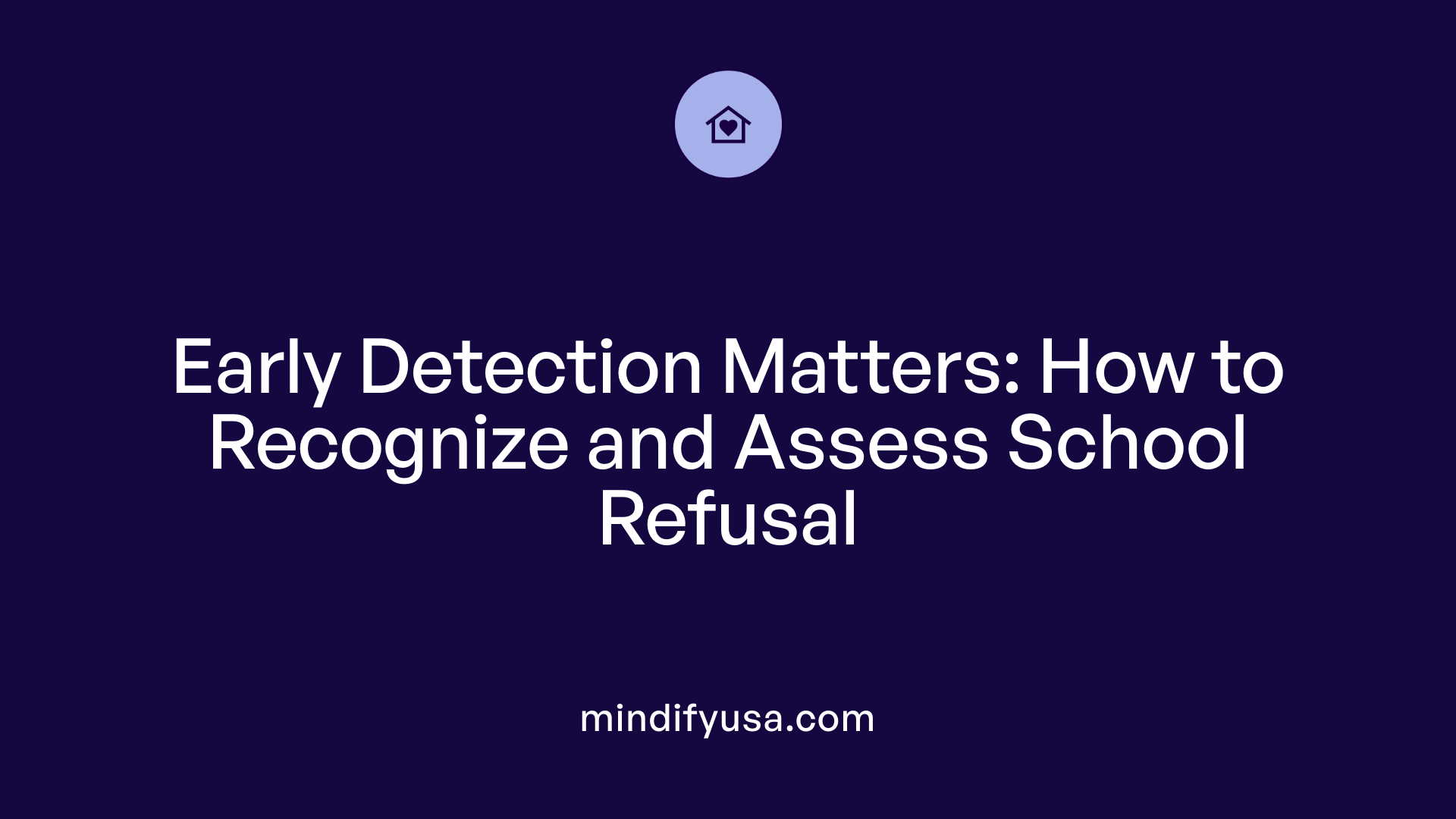
How can school refusal behavior be identified and assessed early?
Early identification of school refusal behavior is crucial to address underlying issues before they escalate, with the goal of preventing academic setbacks and family or social relationship problems. Signs that may indicate school refusal include frequent complaints of physical symptoms, emotional distress before school, or outright refusal to attend.
Monitoring attendance patterns is a fundamental first step. School personnel, such as teachers and counselors, play a vital role by reporting absences and observing behavioral warning signs. Collaboration between educators and caregivers enhances the detection process.
One key tool used for assessment is the School Refusal Assessment Scale-Revised (SRAS-R). It helps determine the specific functions of the refusal behavior, such as avoidance of negative stimuli (like fear of social situations or bullying), escape from academic demands, seeking parental attention, or pursuit of tangible rewards outside school.
Utilizing the SRAS-R alongside interviews and consultations provides a comprehensive picture of the child's situation, guiding tailored interventions. Early recognition and accurate assessment empower schools and families to implement strategies such as gradual reintroduction, positive reinforcement, or mental health support, leading to better outcomes.
Role of school personnel and caregivers
School staff should be trained to notice early signs and use screening tools effectively. Caregivers are encouraged to minimize reinforcing avoidance behaviors at home and support consistency in school attendance. A coordinated approach between home and school increases the likelihood of successful reintegration and symptom reduction in children exhibiting school refusal.
Behavioral and Cognitive-Behavioral Treatment Approaches
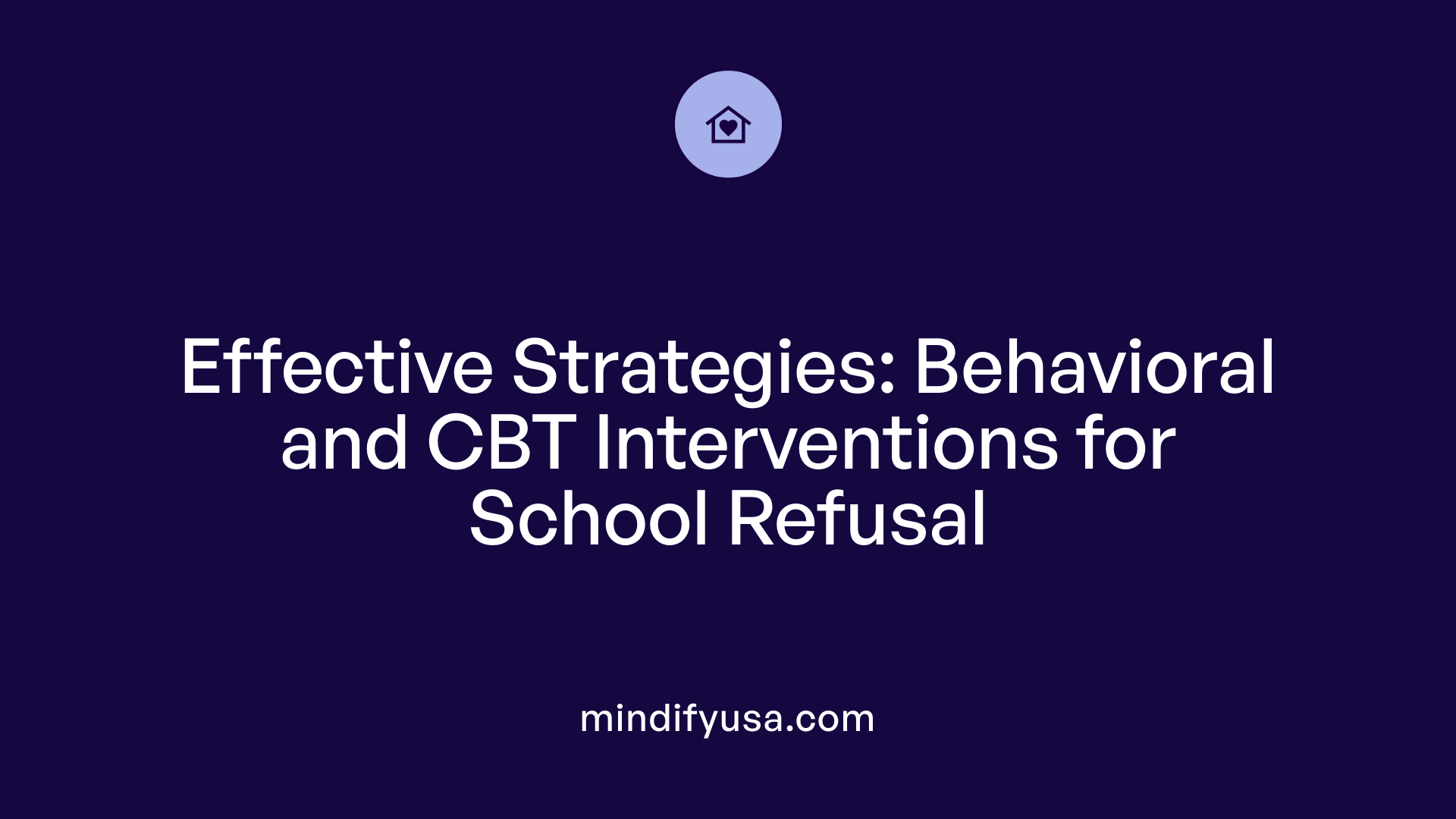
Principles of behavioral and CBT interventions
Behavioral and cognitive-behavioral treatments (CBT) for school refusal involve several core strategies. These include positive reinforcement to encourage gradual exposure to the school setting and cognitive restructuring aimed at challenging and changing negative thoughts related to school attendance. Treatments often include parent and teacher involvement to support consistent behavioral changes and address family dynamics. Interventions may be delivered individually or in groups, integrating relaxation techniques and social skills training to target associated anxieties and social deficits.
Evidence of effectiveness in improving attendance and reducing symptoms
Empirical research and meta-analyses have consistently supported the effectiveness of behavioral and CBT interventions. Large effect sizes (d > 0.8) have been reported in studies, indicating significant improvements in school attendance and reductions in symptoms such as anxiety, depression, fear, and anger. Cognitive-behavioral programs that include psychoeducation, exposure, and social skills components have demonstrated success in both clinical and school settings, particularly when combined with parent and teacher training. These interventions have proven effective not only for youths diagnosed with mental health disorders but also show promise for broader populations with school refusal behaviors.
Role of cognitive restructuring and gradual exposure
Cognitive restructuring within CBT helps youths identify and challenge distorted thoughts like fear of negative events or social rejection that contribute to school refusal. Gradual exposure involves systematically and positively reinforcing incremental steps back to school or specific classrooms, allowing the child to slowly overcome anxiety triggers. This method decreases avoidance behaviors and promotes tolerance of school-related stressors. When paired with parent and teacher involvement, these techniques produce better engagement and sustainable outcomes by addressing both the psychological and environmental factors maintaining school refusal.
Role of Positive Reinforcement and Gradual Exposure

Using rewards to encourage attendance
Positive reinforcement plays a crucial role in improving school attendance among children with school refusal behavior. By providing rewards for gradual increases in attendance, caregivers and educators motivate students to face previously avoided environments. These rewards can range from verbal praise to tangible incentives, all designed to encourage children to participate in school activities progressively without feeling overwhelmed.
Designing graduated exposures to school settings
Graduated exposure is a strategic approach where children are slowly and systematically reintroduced to the school or classroom environment. This method carefully increases the duration and complexity of exposure over time, allowing the child to build tolerance and confidence. For example, a child might start by spending a short period in the school hallway, then progress to spending time in a classroom with support, eventually attending full days. This gradual process reduces anxiety and fear associated with school refusal.
Impact on reducing negative behaviors
Combining positive reinforcement with graduated exposure effectively decreases negative behaviors such as avoidance, anxiety, and emotional distress. Research shows that children responding well to these interventions demonstrate improved attendance and reduced symptoms of anxiety, fear, and anger. Importantly, these methods also foster a sense of achievement and control, which further supports emotional regulation and social engagement within school settings.
Psychosocial Interventions Targeting Related Social and Family Factors
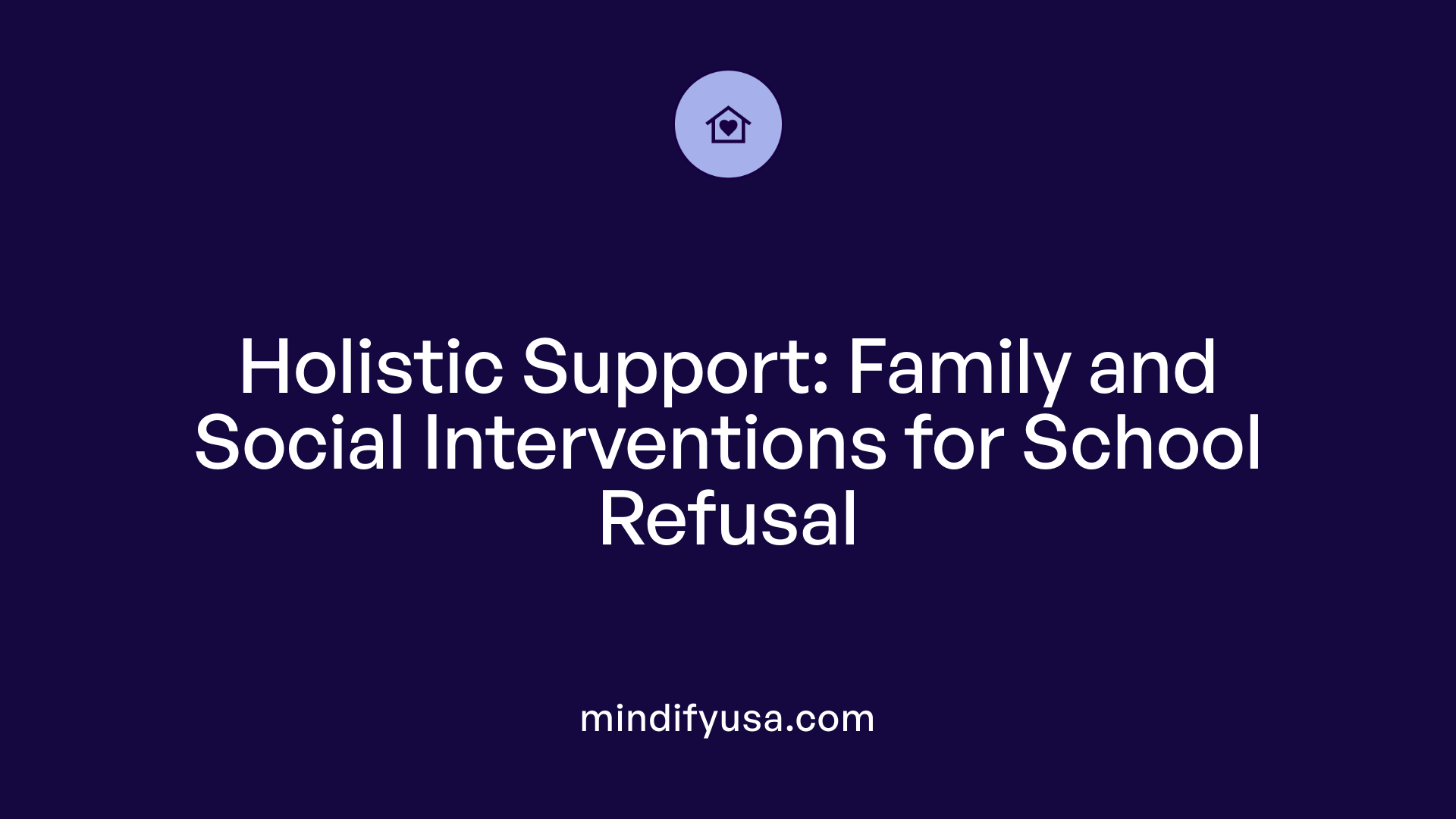
Addressing Social Skills Deficits and Social Isolation
Many children who refuse school struggle with social skills deficits and experience social isolation. Psychosocial interventions often include targeted social skills training to improve interaction abilities and foster peer relationships. Group therapy formats can be especially beneficial, providing safe spaces where youth practice communication, cooperation, and conflict resolution skills in a supportive environment. Reducing social isolation helps diminish feelings of loneliness and anxiety that contribute to school avoidance.
Managing Family Conflict and Improving Family Dynamics
Family conflict is a common factor linked to school refusal behavior. Interventions frequently involve family therapy components aimed at improving communication, resolving conflicts, and building supportive family environments. Caregivers learn strategies to reinforce consistent attendance and reduce enabling behaviors such as inadvertently rewarding school refusal. Enhancing family cohesion creates a more stable home atmosphere conducive to encouraging school participation.
Building Self-Efficacy in Youth
Low self-efficacy, or a lack of confidence in managing school-related challenges, often underlies refusal behavior. Psychosocial programs incorporate skill-building activities to empower youth and foster resilience. Techniques such as goal-setting, problem-solving training, and positive reinforcement for small achievements help children and adolescents gradually regain confidence. With improved self-efficacy, youths are better equipped to face anxiety-provoking school situations and maintain attendance.
Together, these psychosocial approaches address underlying social and familial difficulties contributing to school refusal. By integrating social skills development, family support enhancement, and self-efficacy building, interventions not only reduce avoidance but also promote overall mental health and school reintegration.
Integrating Parent and Teacher Training into Treatment
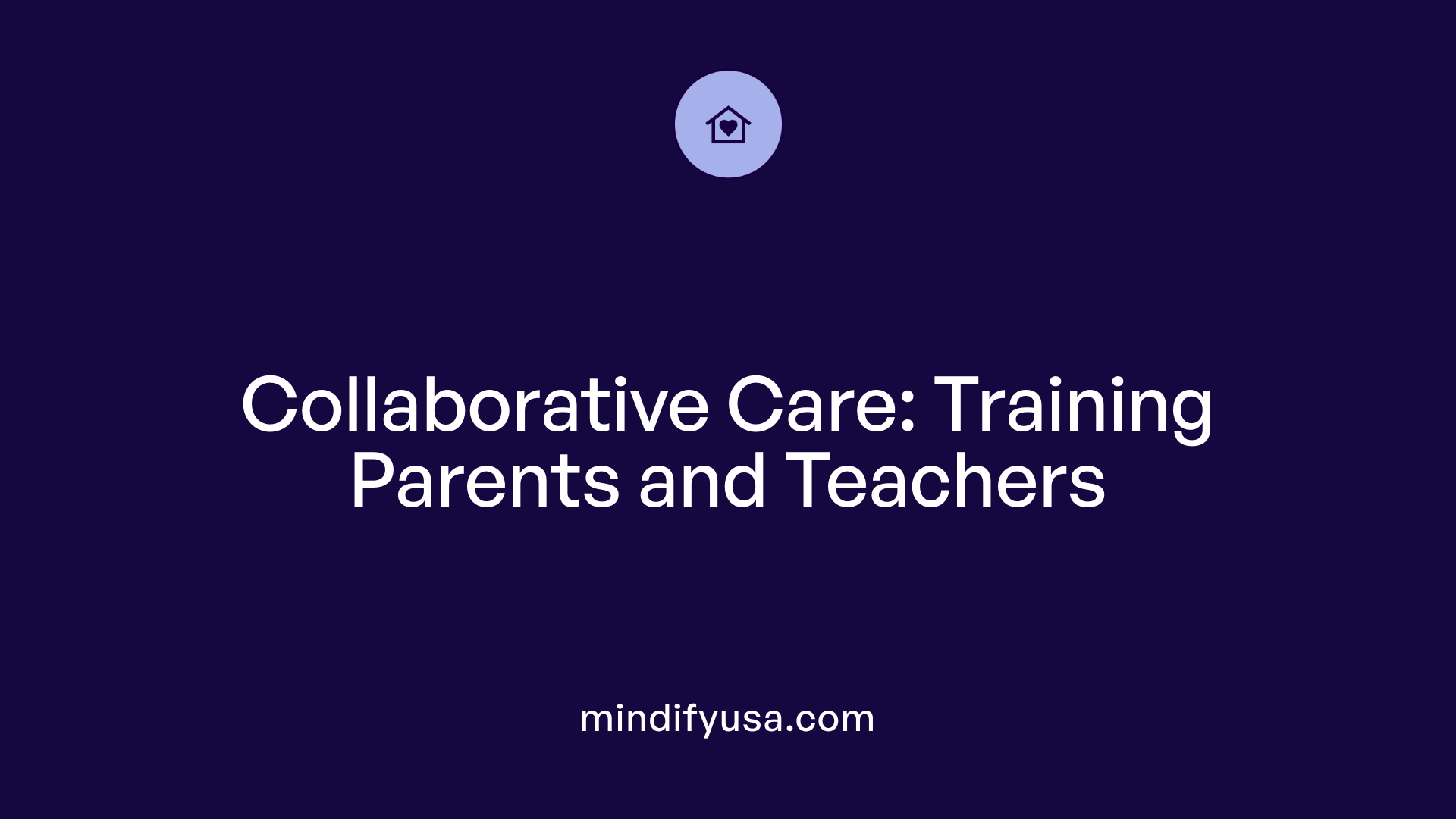
Why is parental involvement important in interventions for school refusal?
Parental involvement is crucial as it reinforces treatment strategies at home, creating a consistent environment that supports gradual school reintegration. Parents receive guidance on minimizing reinforcement of school refusal behaviors and learn to encourage attendance in positive, structured ways. This involvement helps address family dynamics that may contribute to school refusal and empowers caregivers to support their child's emotional needs effectively.
How does teacher training support students dealing with school refusal?
Teacher training equips educators with skills to identify signs of anxiety or distress and to implement classroom strategies that foster a supportive atmosphere. Trained teachers can use positive reinforcement and collaborate on individualized plans, helping reduce students' fears and facilitating smoother transitions back to school. Their active participation ensures that interventions extend beyond therapy sessions into daily school life.
What role does collaboration play among parents, teachers, and mental health professionals?
Collaborative approaches create a unified support network for the child by aligning goals and treatment methods across home and school settings. Regular communication among parents, teachers, and therapists ensures consistent implementation of behavioral and cognitive strategies. This coordination increases treatment efficacy by addressing underlying issues comprehensively and adapting interventions as needed to meet the child's evolving needs.
Group and Individual Cognitive-Behavioral Therapies (ICBT)
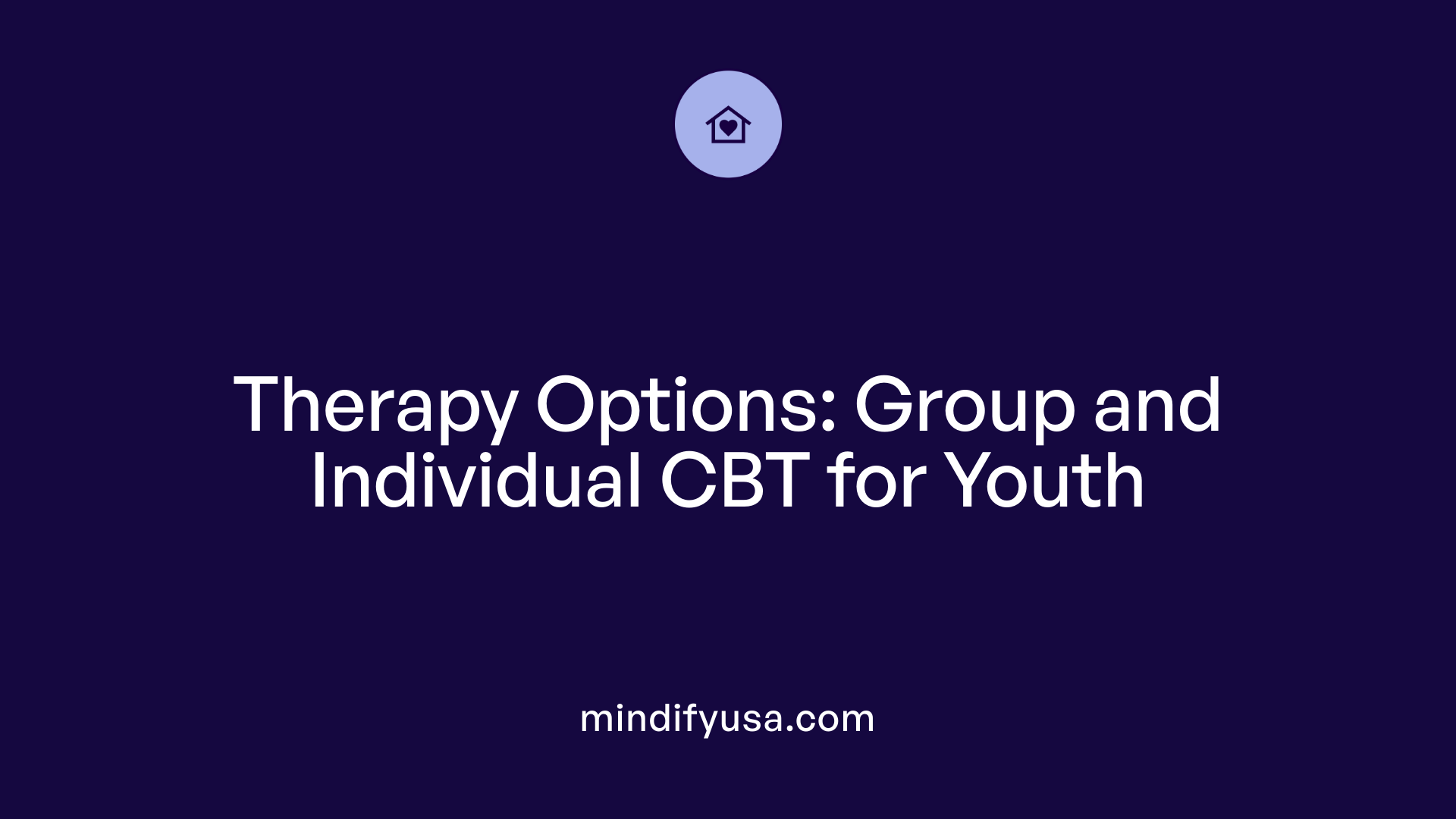
Comparing group versus individual CBT modalities
Group and individual cognitive-behavioral therapies (ICBT) serve as versatile interventions for school refusal, tailoring treatment to the child's needs and setting. Group CBT involves several children working together in a structured environment, promoting peer support and shared learning experiences. This modality often integrates components like social skills training and graded exposure to feared school situations. Individual CBT, on the other hand, offers personalized one-on-one sessions focusing directly on the child's unique anxieties and avoidance behaviors related to school. Both formats commonly include involvement from parents and teachers to reinforce progress and consistency.
Efficacy in treating anxiety and depression linked to school refusal
Research has consistently demonstrated that ICBT yields significant improvements in school attendance and reductions in symptoms such as anxiety and depression in affected youth. Empirical evidence points to both group and individual therapies achieving substantial symptom relief, with some studies reporting large effect sizes (d > 0.8). The inclusion of parent and teacher training further enhances efficacy by ensuring supportive environments beyond therapy sessions, which are critical for sustaining attendance gains.
Supporting social skills and emotional regulation
School refusal often accompanies social skill deficits and emotional dysregulation. Group ICBT particularly excels in addressing these areas through peer interaction and modeled social learning, fostering improved interpersonal competencies. Both group and individual formats incorporate cognitive restructuring and exposure techniques to help children manage fears and regulate emotions linked to school attendance. By enhancing social skills and emotional control, these therapies not only reduce school avoidance but also improve overall psychosocial functioning.
Empirical Evidence and Meta-Analytic Findings
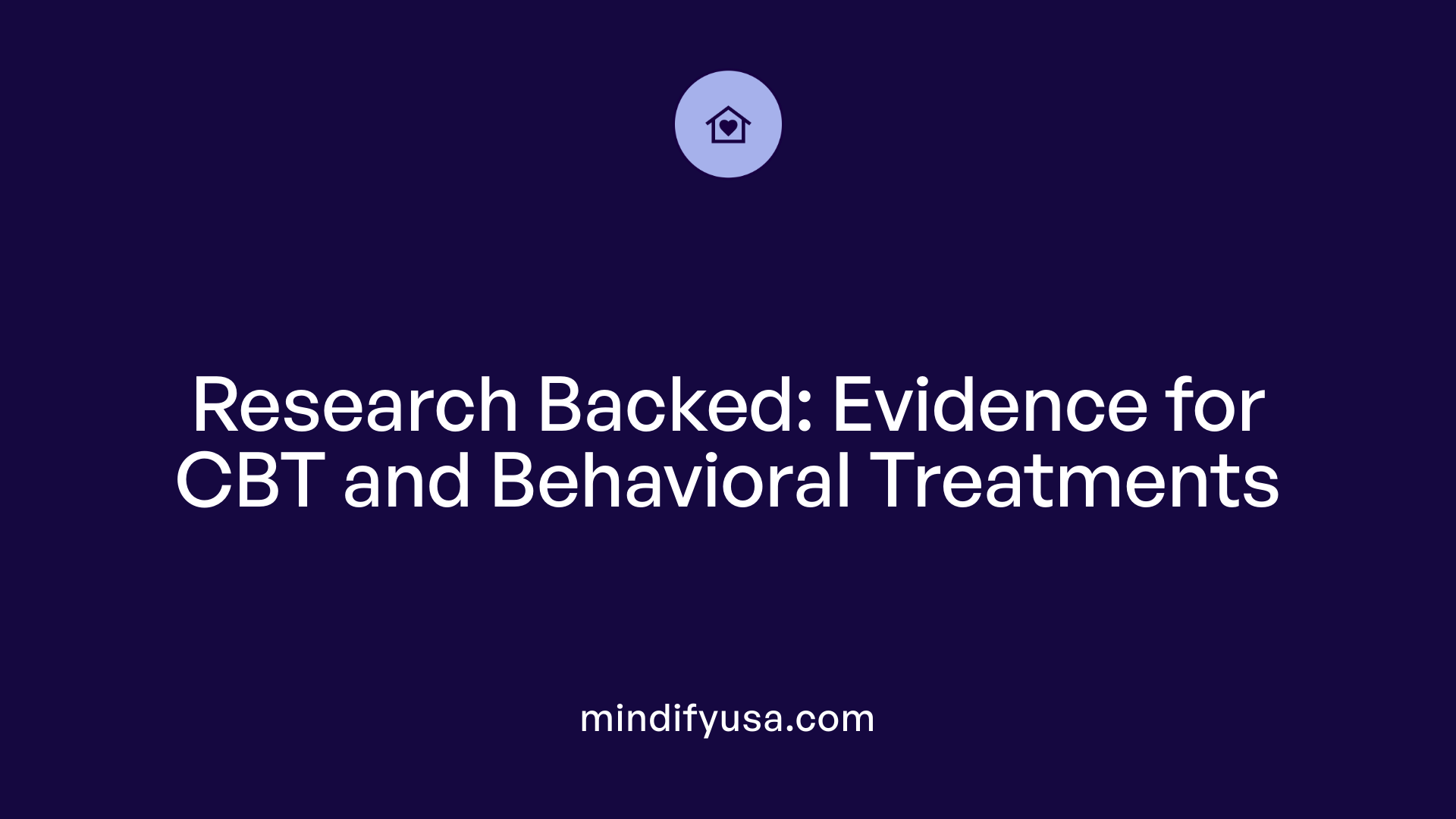
Effect sizes and outcome improvements
Empirical research consistently supports the effectiveness of behavioral and cognitive-behavioral treatments (CBT) for school refusal behavior. Meta-analyses indicate that these interventions yield significant improvements in school attendance and reduce symptoms such as anxiety, depression, and fear. Some studies report large effect sizes, with values exceeding 0.8, which illustrate robust treatment benefits for children and adolescents. Positive reinforcement strategies combined with gradual exposure exercises further enhance attendance outcomes and diminish negative behaviors associated with school refusal.
Studies demonstrating reductions in anxiety, depression, and fear
Research encompassing both group and individual CBT approaches highlights substantial symptom relief in youth struggling with school refusal. These interventions often incorporate parent and teacher involvement, increasing their overall efficacy. Specific programs such as Cool Kids, BCATSS, CBITS, SSET, and SASS have documented decreases in anxiety and depressive symptoms, showing that cognitive-behavioral techniques like cognitive restructuring and exposure therapy translate into measurable emotional improvements. Interventions targeting functional causes of avoidance behaviors, including fears or negative stimuli, demonstrate especially strong benefits.
Limitations and scope of current research
Despite the positive findings, current research primarily focuses on youth with diagnosed mental health disorders, such as anxiety and depression. There is limited evidence regarding children who refuse school for reasons unrelated to formal diagnoses, such as pursuit of external reinforcers or generalized avoidance. This gap points to the need for broader studies that include diverse populations experiencing school refusal. Additionally, questions remain about long-term sustainability and the effectiveness of intervention delivery by school personnel versus mental health specialists, highlighting areas for future investigation.
Tailoring Interventions to the Function of School Refusal

Understanding avoidance behaviors
School refusal often stems from avoidance of negative stimuli such as anxiety-provoking social situations, separation from caregivers, or fear of trauma-related events. Recognizing these avoidance behaviors is crucial in distinguishing school refusal from mere disobedience or rebellion. For many children, school refusal manifests as a protective response to overwhelming emotions like fear, anxiety, or depression.
Customizing treatments based on underlying reasons
Interventions are most effective when tailored to the specific functions driving a child's refusal to attend school. For instance, children avoiding school due to social anxiety benefit from cognitive-behavioral therapies that include graduated exposure to social settings and social skills training. Those whose refusal is tied to separation anxiety may respond better to gradual separation support combined with positive reinforcement. Carefully assessing each child's unique motivation behind school refusal allows clinicians, educators, and caregivers to design individualized plans that directly address these underlying triggers.
Enhanced outcomes with targeted approaches
Empirical research shows that addressing the precise cause of school refusal, especially when involving parents and educational staff, leads to better treatment results. Functional approaches that combine behavioral and cognitive strategies can significantly improve school attendance and reduce symptoms such as anxiety, fear, and depression. For example, interventions that gradually expose students to feared school situations while reinforcing positive attendance behaviors have demonstrated considerable effectiveness. Collaborative involvement from caregivers and teachers also fosters a supportive environment that sustains progress and facilitates reintegration.
| Aspect | Description | Impact on Outcomes |
|---|---|---|
| Avoidance behavior identification | Recognizing if refusal is due to anxiety, trauma, or other factors | Enables targeted intervention plans tailored to root causes |
| Treatment customization | Matching intervention type to the function of refusal | Enhances treatment efficacy and addresses individual needs |
| Parental and educator involvement | Engaging caregivers and school staff | Increases support consistency and improves long-term success |
Tailoring interventions to the specific functions of school refusal is a promising route to achieving lasting improvements in school attendance and emotional well-being.
Addressing School Refusal in Youth Without Diagnosed Mental Health Conditions
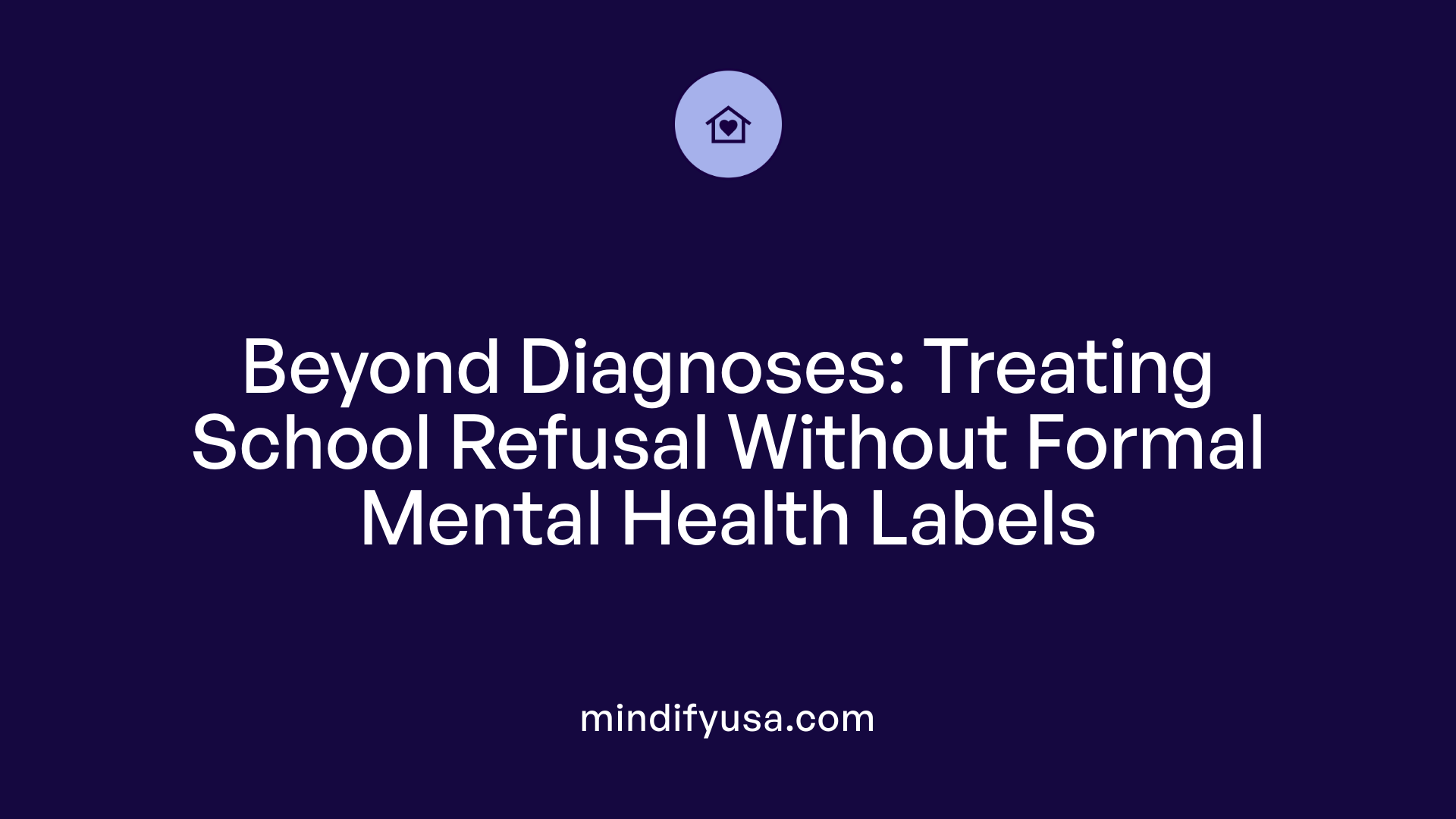
Challenges in Treating Youth Without Formal Diagnoses
School refusal often receives treatment focused on youths with diagnosed mental health disorders such as anxiety or depression. However, many children who refuse school do not have formal diagnoses, presenting unique challenges. These youths might not display clear-cut clinical symptoms, which can make early identification and intervention more difficult. Without recognized disorders, traditional cognitive-behavioral therapies (CBT) tailored for anxiety or depression may require modification to effectively engage these individuals.
Factors Such as External Reinforcers for Refusal
In youth without formal mental health diagnoses, school refusal may sometimes be motivated by external reinforcers unrelated to anxiety or fear. For example, children might skip school to access preferred activities outside of school or to seek attention. These external incentives complicate treatment because the refusal behavior serves a different function than avoidance of negative situations. Interventions must therefore include strategies addressing these motivations, such as altering reinforcement patterns and involving caregivers in reducing inadvertent rewards for absence.
Need for Further Research and Intervention Adaptation
Current evidence supporting behavioral and cognitive strategies largely comes from studies involving clinically diagnosed youth, creating a gap in knowledge about effective approaches for non-diagnosed populations. More research is necessary to understand the characteristics and needs of these children. Additionally, treatments may need adaptation to address diverse causes of school refusal beyond mental health symptoms, incorporating tailored engagement methods and involvement of educational and family stakeholders to optimize outcomes.
Together, these points emphasize the importance of broadening the scope of school refusal interventions. Expanding research and developing nuanced treatment plans can better support youths who refuse school for reasons not linked to diagnosed mental health conditions.
School-Based Mental Health Programs: Accessibility and Effectiveness

Why Are Schools Unique Settings for Identification and Treatment?
Schools offer a distinctive environment for identifying and treating mental health issues like anxiety and depression in children and adolescents. Because anxiety symptoms often emerge in the academic and social realms of school life, educators and school staff can observe these signs firsthand. The school setting also allows clinicians to tailor interventions to real-world challenges that youth face daily, such as peer interactions and classroom participation.
What Evidence Supports School-Based Anxiety Treatments?
Empirical research shows strong support for various school-based programs targeting anxiety and depression. Programs like Cool Kids, BCATSS (Baltimore Child Anxiety Treatment Study in the Schools), CBITS (Cognitive-Behavioral Intervention for Trauma in Schools), SSET (Support for Students Exposed to Trauma), and SASS (Skills for Academic and Social Success) have demonstrated significant symptom reductions in anxiety and trauma-related disorders. These interventions typically use cognitive-behavioral therapy (CBT) methods including psychoeducation, relaxation techniques, cognitive restructuring, and exposure therapy.
For example, the Cool Kids group program significantly lowers anxiety symptoms over eight sessions, while CBITS targets PTSD and depression related to trauma with notable clinical improvements. These treatments often incorporate parent and teacher training, improving support systems around the child.
How Do These Programs Benefit Youth Who Might Not Access Traditional Services?
School-based interventions provide crucial access for children who might not receive mental health services otherwise, especially in underserved or low-income populations. Delivering treatments within the school reduces barriers such as transportation, cost, and stigma that can prevent families from seeking outside care.
Educational settings can more easily integrate mental health into daily routines, offering ongoing support and skill generalization. Further, training school personnel to deliver these interventions could enhance sustainability and broaden reach, ensuring more youth receive timely and effective care.
Embedding mental health programs into school culture also promotes early identification through staff training and school-wide screenings, increasing the likelihood of successful early intervention and improved long-term outcomes.
Notable School-Based Anxiety Interventions: Overview of Programs

Descriptions of Cool Kids, BCATSS, CBITS, SSET, and SASS
Several evidence-based school anxiety intervention programs have been developed and tested to address anxiety and related symptoms among youth. The Cool Kids program is an eight-session group cognitive-behavioral therapy (CBT) that includes psychoeducation, cognitive restructuring, graduated exposure, and social skills training. It has demonstrated significant reductions in anxiety symptoms when delivered by trained personnel.
The Baltimore Child Anxiety Treatment Study in the Schools (BCATSS) targets urban, low-income African American populations. This 12-week program incorporates psychoeducation, relaxation techniques, cognitive restructuring, and exposure exercises. Research supports its effectiveness in reducing anxiety in these youth.
Cognitive-Behavioral Intervention for Trauma in Schools (CBITS) focuses on children with PTSD and depression secondary to trauma. The intervention comprises psychoeducation, relaxation, coping skills, trauma exposure, and processing of traumatic memories. Studies show CBITS significantly reduces PTSD and depressive symptoms.
An adaptation of CBITS, Support for Students Exposed to Trauma (SSET), is a group-based, school-friendly intervention delivered by school counselors. It has demonstrated feasibility and modest improvements in PTSD and depression symptoms.
The Skills for Academic and Social Success (SASS) program is a school-based group CBT designed for adolescents with social anxiety disorder. It provides social skills training, graduated in vivo exposures, and includes parent, teacher, and social event components, resulting in high responder rates and symptom improvement.
Program Components such as Psychoeducation and Exposure
Common components across these programs include psychoeducation, which helps students understand their anxiety and symptoms; cognitive restructuring, aimed at challenging negative thoughts; graduated exposure to feared stimuli or situations; relaxation and coping skills training; as well as social skills development to improve interpersonal functioning.
Target Populations and Outcome Evidence
These interventions primarily serve children and adolescents experiencing anxiety disorders, PTSD, and depression, especially those whose symptoms interfere with school attendance and performance. The programs have been adapted for diverse populations, including low-income urban youth and trauma-exposed students.
Empirical evidence supports the effectiveness of these programs in decreasing anxiety and trauma-related symptoms, improving school attendance, and enhancing social and academic functioning. For example, Cool Kids and BCATSS show significant anxiety reduction, while CBITS and SSET provide trauma-focused symptom relief. SASS has shown efficacy in substantially reducing social anxiety symptoms in adolescents.
Together, these school-based CBT interventions offer promising avenues for integrating mental health services within educational settings to support vulnerable youth populations.
Cool Kids Program: Structure and Outcomes
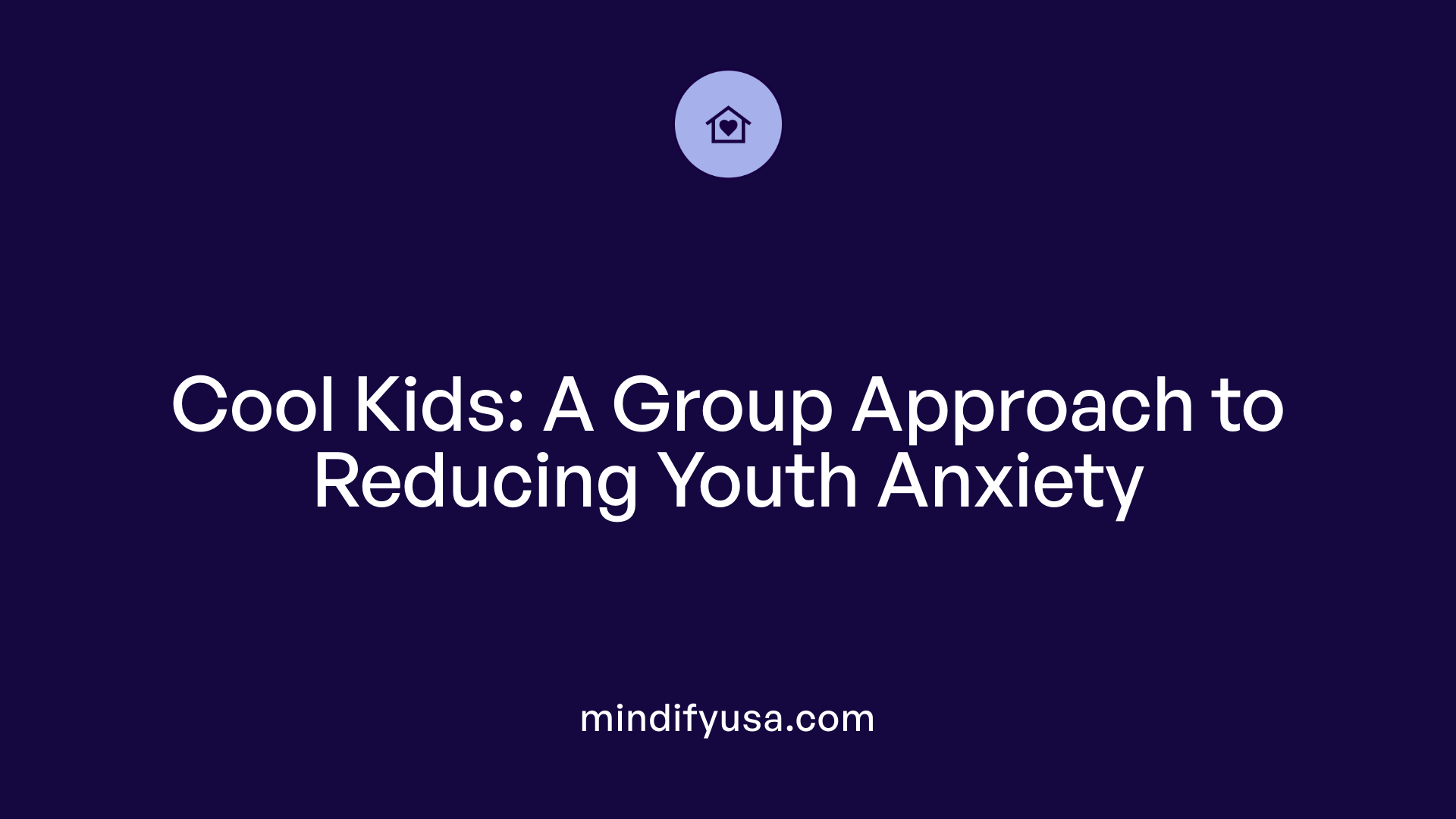
Group CBT format
The Cool Kids program is delivered in a group cognitive-behavioral therapy (CBT) format, typically spanning eight sessions. This approach allows peer interaction and shared experiences, which can enhance motivation and normalize challenges associated with anxiety. The group setting also facilitates social skill development in a supportive environment.
Focus on cognitive restructuring and social skills
Core components of the program include psychoeducation to help children understand anxiety, cognitive restructuring to challenge and modify negative thoughts, graduated exposure to feared situations in a gradual and controlled manner, and social skills training. The program’s emphasis on social competence is particularly important, addressing social isolation and deficits that can contribute to school refusal.
Research outcomes showing symptom reduction
Empirical studies demonstrate that Cool Kids leads to significant decreases in anxiety symptoms among participating youths. The program has shown effectiveness when delivered by trained personnel in school settings, producing meaningful improvements in both anxiety severity and related functional outcomes such as school attendance. These positive results underscore Cool Kids as a valuable intervention option for youth experiencing anxiety-related school refusal.
Baltimore Child Anxiety Treatment Study in the Schools (BCATSS)

Adaptation for Urban, Low-Income Populations
The Baltimore Child Anxiety Treatment Study in the Schools (BCATSS) was specifically adapted to meet the needs of urban, low-income African American youth. This adaptation helps ensure that the intervention is culturally sensitive and accessible to populations that traditionally have less access to mental health services.
Components Including Relaxation and Exposure Therapy
BCATSS consists of 12 weekly sessions focusing on multiple core elements designed to reduce anxiety symptoms. Key components include psychoeducation about anxiety, relaxation techniques to manage physiological symptoms, cognitive restructuring to challenge negative thoughts, and graduated exposure therapy to help youth face feared situations gradually and safely.
Efficacy in Anxiety Symptom Reduction
Empirical evidence supports the effectiveness of BCATSS in decreasing anxiety symptoms among participating children and adolescents. Studies have reported significant improvements in anxiety reduction, making BCATSS a promising school-based intervention that not only addresses mental health needs but also supports improved school attendance and functioning.
| Aspect | Details | Significance |
|---|---|---|
| Target Population | Urban, low-income African American youth | Ensures cultural relevance and increases accessibility |
| Session Structure | 12 weekly sessions | Provides sustained intervention over three months |
| Therapeutic Components | Psychoeducation, relaxation, cognitive restructuring, exposure therapy | Comprehensive approach addressing cognitive, emotional, and behavioral aspects of anxiety |
| Research Outcomes | Significant anxiety symptom reduction | Validates BCATSS effectiveness in school settings |
Cognitive-Behavioral Intervention for Trauma in Schools (CBITS) and Support for Students Exposed to Trauma (SSET)
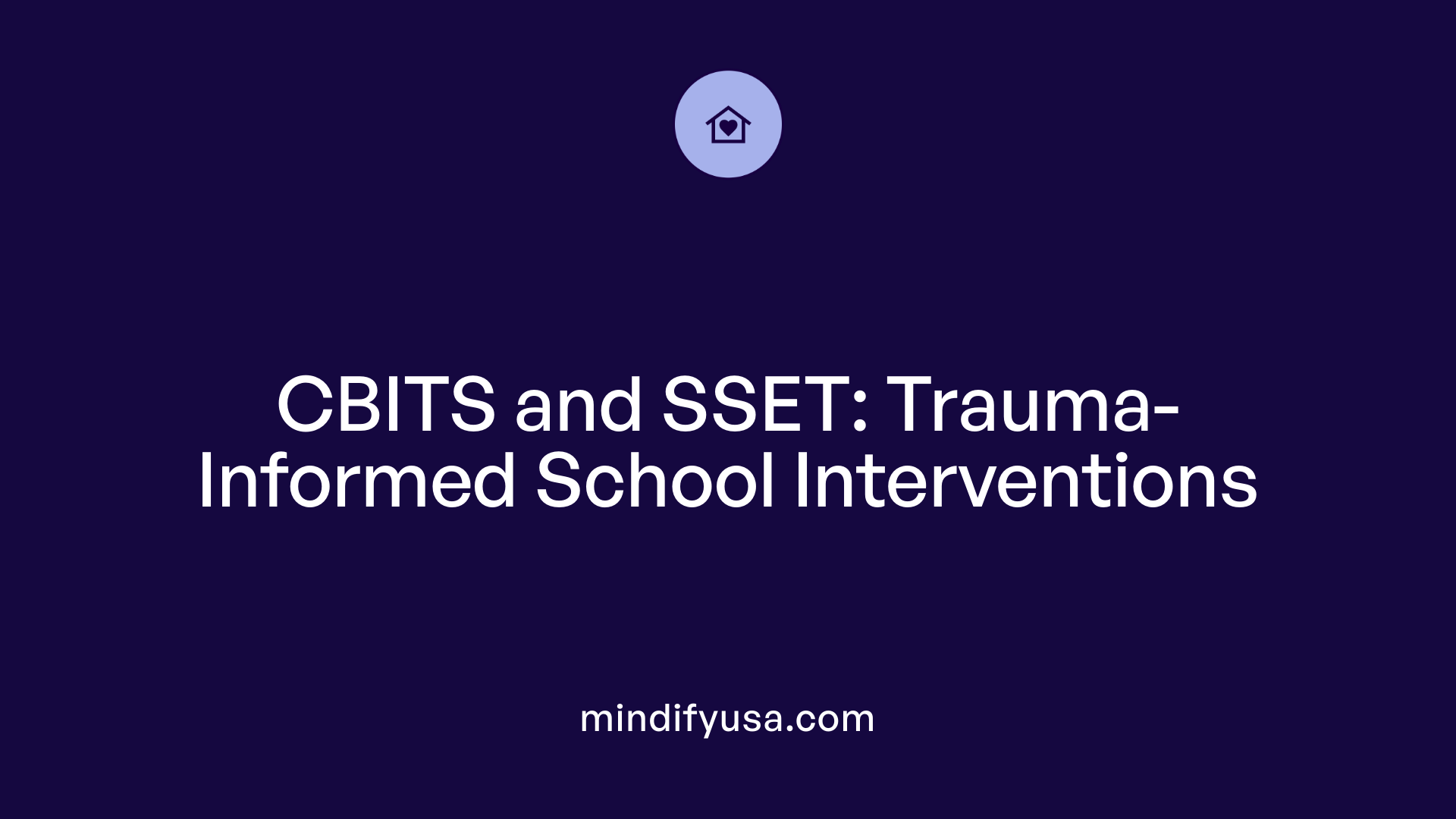
Targeting trauma-related PTSD and depression
Both CBITS and SSET are school-based cognitive-behavioral programs specifically designed to help youth who have experienced trauma. CBITS focuses on reducing symptoms of post-traumatic stress disorder (PTSD) and depression that develop secondary to traumatic events such as school violence or abuse. SSET adapts many of CBITS' components to provide a more accessible, school-friendly group format for addressing PTSD and depression among students exposed to trauma.
Group-based delivery by school counselors
CBITS is delivered through structured group sessions that incorporate psychoeducation, relaxation techniques, coping skills training, graduated exposure, and processing of traumatic memories. Similarly, SSET is a group intervention typically conducted by school counselors, aiming to fit seamlessly within schools' existing mental health services. This group-based approach facilitates peer support and enables schools to reach multiple affected students efficiently.
Evidenced symptom improvements and feasibility
Empirical studies demonstrate CBITS leads to significant reductions in PTSD and depressive symptoms in trauma-affected youth. SSET also shows promise with smaller but meaningful improvements in these symptoms. The adaptations found in SSET make it more feasible for implementation in a wide range of school settings by non-specialist personnel, such as counselors rather than clinical psychologists. Together, these programs highlight the effectiveness and practical delivery options for treating trauma-related emotional disturbances in school environments.
Skills for Academic and Social Success (SASS) Program
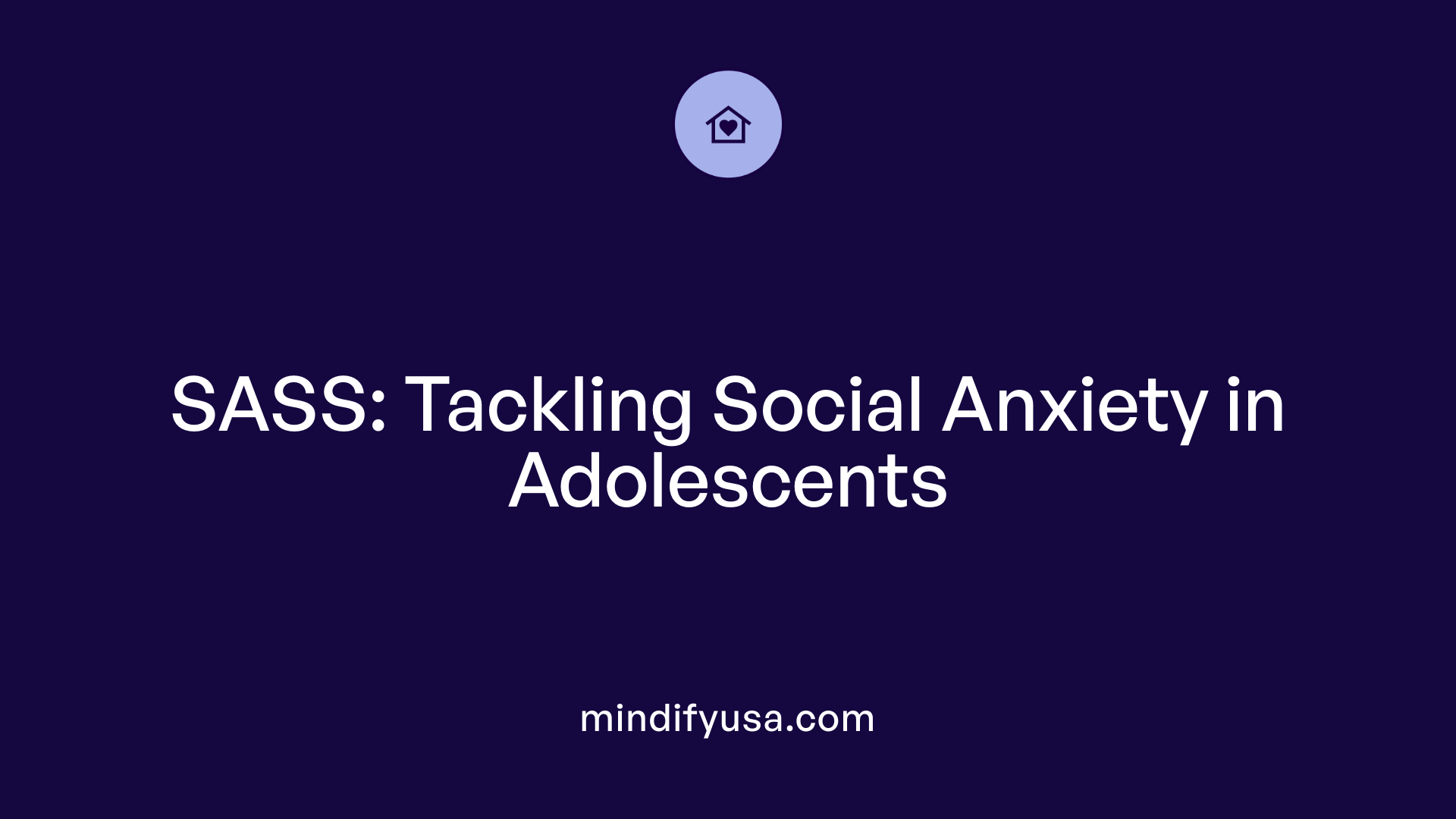
Addressing Social Anxiety Disorder in Adolescents
The Skills for Academic and Social Success (SASS) program is a targeted school-based cognitive-behavioral therapy designed specifically for adolescents struggling with social anxiety disorder. Social anxiety can significantly impair school attendance and participation due to intense fear of social interactions and scrutiny. SASS aims to reduce these symptoms and improve functional outcomes to enhance academic and social engagement.
Incorporation of Social Skills Training and Exposure
SASS integrates structured social skills training alongside graduated in vivo exposures. This means adolescents learn and practice essential social skills in a supportive setting while gradually confronting anxiety-provoking social situations outside therapy. The exposure component helps students reduce avoidance behaviors by building confidence and coping strategies to manage anxiety in real-world social environments.
Parental and Teacher Involvement
A distinctive feature of SASS is the inclusion of parents and teachers in the intervention process. This collaborative approach ensures that social and academic support extends beyond the group therapy sessions. Parents learn strategies to reinforce progress at home, while teachers provide consistent encouragement and accommodations in the classroom. By involving these key figures, the program fosters a more supportive environment, promoting sustainable improvements in school attendance and participation.
Medication and Multidisciplinary Treatment Approaches
What are the comprehensive mental health services available for treating anxiety and depression?
Comprehensive treatment for anxiety and depression in youth commonly involves a combination of medication and therapeutic interventions. Selective Serotonin Reuptake Inhibitors (SSRIs) are frequently prescribed medications that help regulate mood and anxiety symptoms. These medications are particularly useful when anxiety or depression symptoms are moderate to severe or when therapy alone does not lead to sufficient improvement.
However, medication is most effective when integrated with psychological treatments, especially cognitive-behavioral therapy (CBT). CBT focuses on challenging and restructuring negative thought patterns and behaviors that contribute to anxiety and depression. Exposure therapy, a CBT component, helps youths gradually face feared situations like school attendance in a supportive environment. Together, these treatments address both the neurochemical and psychosocial aspects of mental health disorders.
Multidisciplinary care involves collaboration among mental health professionals such as psychiatrists, clinical psychologists, social workers, and trauma therapists. It also includes educators and family members to form a comprehensive plan tailored to the child's specific needs. Early assessment, psychoeducation, and ongoing monitoring help track progress and adjust interventions as needed. The goal is to support the child's functioning across school, home, and social settings, ensuring sustainable improvements in attendance and emotional well-being.
This integrated model recognizes that school refusal and related mental health challenges are multifaceted. Medication supports symptom relief, while therapeutic strategies empower children and families with skills and coping mechanisms. Together with collaborative care, this approach improves outcomes and promotes successful school reintegration.
Creating Supportive School Environments to Sustain Treatment Gains

Embedding Mental Health Programs into School Culture
To sustain the positive effects of treatments for school refusal and anxiety-related symptoms, integrating mental health programs into the fabric of school life is essential. Embedding these programs within the school's culture enhances acceptance and normalizes seeking support, helping reduce stigma associated with mental health interventions.
Incorporating Interventions into Classroom Activities
Incorporating treatment components into regular classroom activities allows children to practice skills such as cognitive restructuring and gradual exposure in naturalistic settings. This approach reinforces therapeutic gains, encourages peer interaction, and helps generalize coping strategies across academic and social contexts.
Enhancing Sustainability and Accessibility
Increasing the sustainability and accessibility of mental health interventions in schools relies on training school personnel, including counselors and teachers, to deliver evidence-based programs effectively. This model broadens the reach to youth who might not have access to external mental health services, ensuring continuous support and early identification of at-risk students.
Integrating mental health services as part of everyday school routines creates supportive environments that facilitate both treatment success and long-term wellness for children struggling with school refusal and anxiety disorders.
Training and Support for School Personnel Delivering Interventions
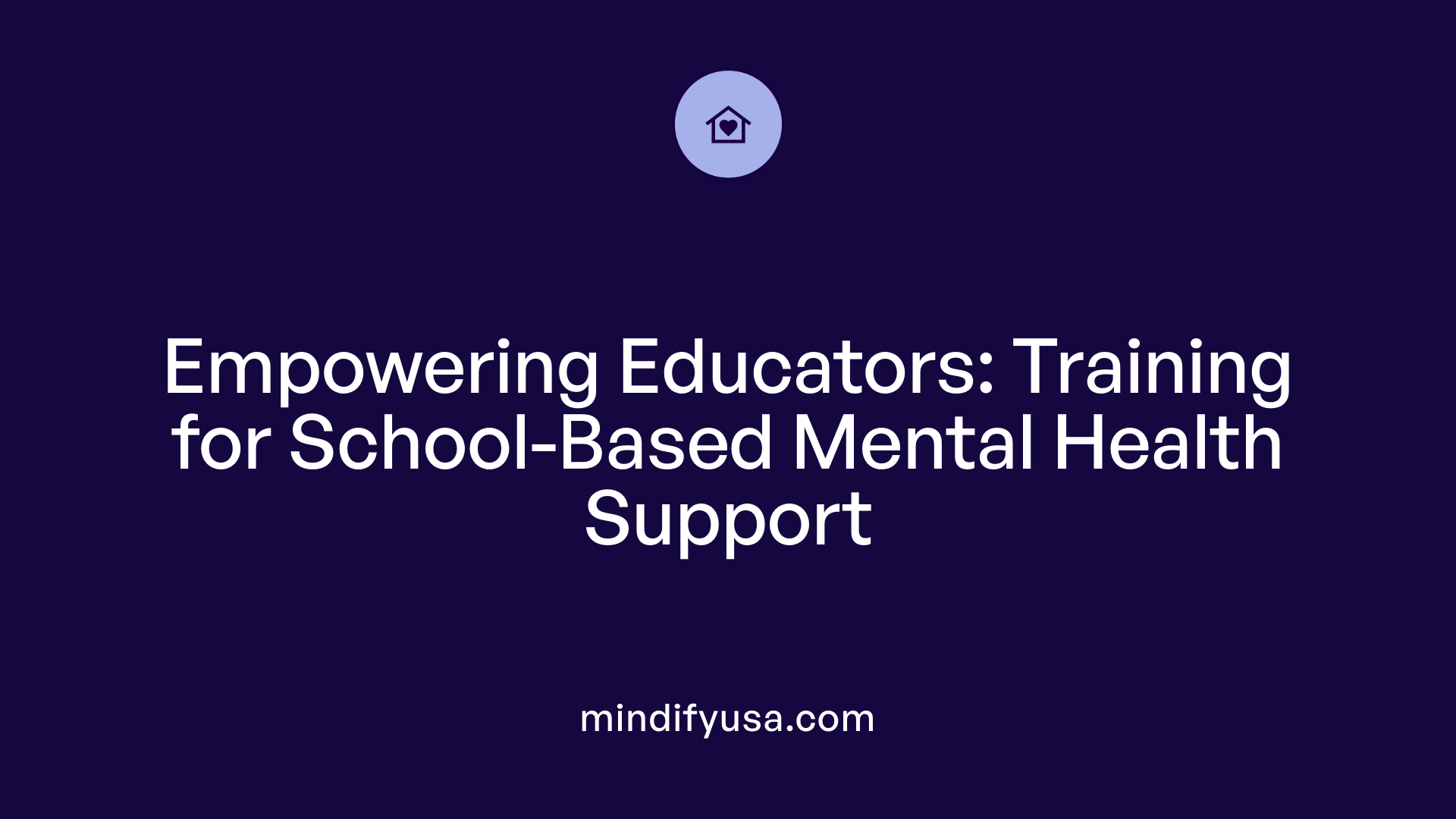
Importance of treatment fidelity and competence
Ensuring that school personnel deliver mental health interventions with fidelity and competence is critical to achieving positive outcomes in treating school refusal and anxiety disorders. Treatment fidelity refers to how closely providers adhere to the intervention protocols, while competence measures their skill in delivering these treatments effectively. High fidelity and competence are linked to better symptom reduction and increased school attendance among youth.
Training models for teachers and counselors
Various training approaches have been developed to equip teachers, counselors, and other school staff to deliver cognitive-behavioral and psychosocial interventions. These models often include initial instruction through workshops or online modules, supplemented by practical demonstrations and role-playing exercises. Programs emphasize understanding intervention components such as cognitive restructuring, exposure therapy, and positive reinforcement techniques. Training also focuses on recognizing anxiety-related behaviors and tailoring strategies to the underlying function of school refusal.
Ongoing supervision and quality assurance
Ongoing supervision, coaching, and quality assurance measures are essential to maintain treatment integrity over time. Supervisors provide feedback, troubleshoot challenges, and ensure adherence to the intervention protocols. Regular fidelity checks and competence evaluations help identify training gaps and guide continuous professional development. Schools are exploring sustainable models where supervision is integrated into existing support structures to enable long-term program success.
Together, these elements build capacity within schools to provide effective mental health support, extending access to evidence-based interventions and promoting sustainable improvements in attendance and wellbeing among students.
Caregiver Strategies and Home Environment Modifications

Minimizing reinforcement of school refusal behaviors at home
Caregivers play a crucial role in managing school refusal by minimizing behaviors that might inadvertently encourage refusal. This involves avoiding offering special privileges or excessive attention when a child refuses to attend school. Instead, caregivers should maintain clear and consistent expectations around school attendance, helping children understand that staying home is not usually rewarded.
Creating home environments supportive of school attendance
Establishing a home environment that mirrors school routines can support gradual reintegration. This may include maintaining regular wake-up times, structured daily activities resembling the school day, and encouraging independence with homework and self-care. Such consistency reduces the contrast between home and school, easing the transition back to attendance.
Collaborative planning with mental health professionals
Working closely with mental health providers enables caregivers to develop tailored plans addressing the child's specific emotional and behavioral needs. Collaborative strategies often include scheduled exposures to school settings, emotional regulation techniques, and communication with educators to align home and school supports. This coordinated approach can improve outcomes by addressing underlying issues such as anxiety, fear, or depression while ensuring consistency across environments.
Comprehensive Individualized Plans for Successful Reintegration

Collaboration between caregivers, educators, and clinicians
Successful reintegration of children with school refusal behavior relies on close collaboration among caregivers, educators, and mental health professionals. These groups work together to understand the child's unique challenges and develop strategies that encourage consistent attendance. Caregivers help monitor symptoms and reinforce positive behaviors at home, while educators provide necessary academic and social support within the school environment. Clinicians contribute psychological expertise to address underlying mental health issues such as anxiety or depression.
Developing tailored treatment and school reentry plans
Each child’s school refusal situation is distinct, requiring an individualized plan that integrates therapeutic interventions with practical school reentry steps. Tailored plans often combine cognitive-behavioral therapy techniques, positive reinforcement for gradual exposure to school settings, and clear, consistent attendance expectations. Regular communication among all parties ensures adaptations can be made as the child progresses, and that any emerging barriers are addressed swiftly.
Addressing academic, social, and emotional needs
Effective plans encompass academic accommodations to ease learning pressure, social skills training to reduce isolation, and emotional support to alleviate fears or depressive symptoms. This holistic approach targets not only the avoidance behavior but also the factors that maintain it, such as family conflict or low self-efficacy. Interventions may include school-based programs to build coping skills alongside classroom supports and home-based reinforcement, providing a supportive structure for the child's full reintegration into school life.
Bridging Mental Health and Education to Overcome School Refusal
School refusal behavior is a multifaceted challenge primarily rooted in anxiety, depression, and trauma. Addressing it effectively demands evidence-based, comprehensive mental health interventions that incorporate behavioral and cognitive strategies, psychosocial support, medication when appropriate, and the active involvement of parents, educators, and mental health professionals. Schools wield unique potential to serve as accessible venues for early identification and treatment delivery, supporting sustainable reintegration through tailored programming and creating environments conducive to recovery and attendance. Ongoing training of school personnel, embedding interventions into daily school life, and fostering collaborative individualized plans are essential components to ensure youth affected by school refusal regain academic footing and emotional well-being, paving the way for healthier development and future success.
References
- Psychosocial Interventions for School Refusal Behavior in ...
- Understanding School Refusal in Kids and Teens
- School-Based Anxiety Treatments for Children and Adolescents
- Treating School Refusal in Youth
- Comprehensive Mental Health Services in Oak Brook
- Behavioral Health Services, Psychiatry Services
- Mental Health Services | Chicago





































































































